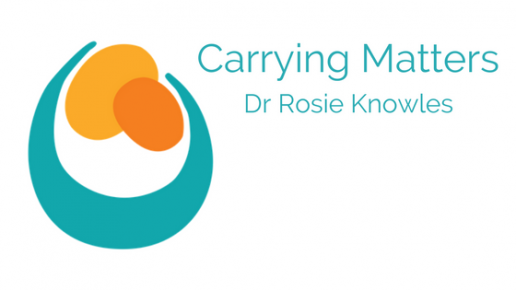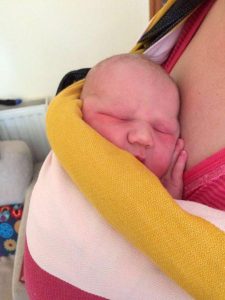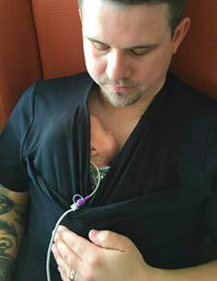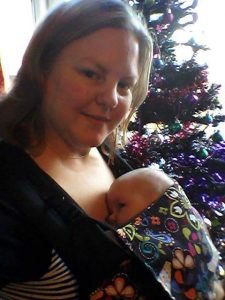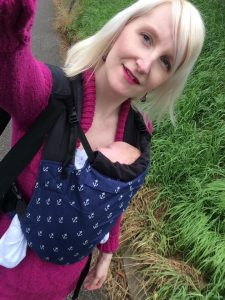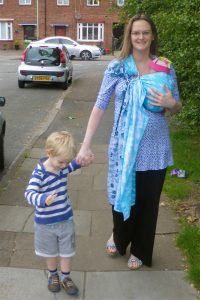Is carrying in the postnatal period (in the early weeks after a baby is born) safe?
Babies want to be held close from the very moment they enter the outside world; they crave contact and many will spend their first few days and weeks sleeping in their parents’ arms and feeding frequently, enjoying this close interaction.
Pregnancy can be tiring and uncomfortable for many, due to our changing bodies and habits. We are no longer an upright species but a sedentary one, to our great anatomical and physiological disadvantages; chronic pain is a significant problem for increasing numbers of people in our society. Symphysis Pubis Dysfunction can be debilitating for pregnant women, and there is a growing belief that many women’s bodies are frequently not in the optimal condition to carry a child and thus take much longer to recover from pregnancy than our forebears. Ligament softening and laxity (from the hormonal changes preparing a body to deliver a fetus) can take some time to resolve fully especially if there has been pre-existing back pain and poor posture, and breastfeeding may prolong the effects of relaxin.
Labour, while exhilarating and empowering for some, can be exhausting for others, especially if prolonged. The recent historical practice of lying down for delivery is in marked contrast to how most women around the world across history and cultures have given birth (upright, squatting or kneeling). The natural birth movement and the emergence of doulas to support women with their delivery choices mirrors a growing desire to get back to our ancient human roots, which may also encourage speedier recovery from labour and birth.
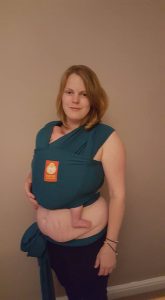
The rate of caesarean sections (both planned and as emergency) is high in Western society, currently between 20-25% of births in the UK (with some regional variation). A caesarean section is major abdominal surgery and some recovery time from this is to be expected, and varies enormously from woman to woman, depending on the reasons for the operation. Women are advised to avoid heavy lifting, “carry nothing heavier than your baby”, and not to drive for at least six weeks after birth. Scars can be uncomfortable and slow to heal for some, and some may experience abdominal pain for a while afterwards. Babies may come early and be very frail for several weeks.
Therefore it is not surprising that many mothers worry that after labour and birth, they may not be strong or well enough to carry their newborns in their arms for prolonged periods. Many will have toddlers at home needing the reassurance of their mother’s loving arms to help them cope with the newcomer’s arrival. Paternity or parental leave is often short; in a few weeks mothers are often required to manage at home alone.
Carrying your child in the postnatal period is important.
The early weeks are vital for bonding and attachment, providing continuity and security, promoting breastfeeding and helping to reduce depression. So yes, we should carry our babies somehow after birth. This doesn’t need a sling; people can hold their babies while sitting down and while reclining just as much as while they stand and walk around; it is the closeness and the contact and the skin to skin that promotes bonding and oxytocin release that matters. It helps to shape baby’s brain, and also has a positive effect on yours! Furthermore it can be a great way to ensure any older children still feel connected to you, as your hands are free.
Carrying a newborn baby can be very healing if birth has been traumatic or there has been previous bereavement.
“”I had a tiny baby (4lb5oz) and experienced a traumatic birth, I suffered with PTSD. At times this meant I was very anxious and wanted to keep my baby close to me to be sure she was safe. I started with a stretchy wrap when P was just 3 weeks old. I truly believe babywearing strengthened my attachment with her and helped me to cope every day.” Anon
There are some garments of clothing that can be worn in hospital or in the early weeks after birth; mimicking the practice of putting a tiny newborn down the front of the shirt. Some of these garments (known as skin to skin tops or kangaroo care clothing) are designed for keeping baby skin to skin to the parent while reclining, and are not hands-free.
Others are a little more structured (at least two layers of stretchy fabric) and provide enough support for baby that a parent can be hands-free and walk around, similar to a stretchy wrap. These can be most useful in hospital environments for their coolness and simplicity.
Please note that if your baby is premature or very small (under 6lb) it is wise to seek the advice of a specialist baby-carrying consultant; many “newborn” carriers, including some stretchy wraps will not provide enough support without guidance on how to use for these babies with special needs, and many buckle carriers will be much too big.
Breast and bottle-feeding can cause back, neck and shoulder pains, as can prolonged periods of one-sided carrying (which can also affect the pelvic floor and the symphysis pubis.) Being alert to the body’s signals of discomfort and acting on them to frequently redistribute the strain is of great benefit in building up tolerance and strength.
As women recover their strength and are able to do more each day, their mobile carrying abilities will grow too. As womens’ bodies settle back down after pregnancy, with appropriate pelvic floor toning and correction of posture and alignment, carrying will become easier. Furthermore, as baby gets bigger and heavier, the parent’s muscles will adapt to the gradually increasing weight and become more toned day by day, the more often they carry.
“Much of my pre-pregnancy life was spent in the mountains, and carrying my babies after their birth helped me get back in touch with my “home”. It enabled me to very gradually and gently regain some fitness away from busy streets, and felt like less strain on the scar area than pushing a double buggy uphill.” Carissa

Keeping a baby’s weight high, snug and central will encourage loading across the large weight-bearing axes of the body, thereby preventing strain on muscles, ligaments and the pelvic floor, and avoiding abdominal pressure. Lifting a baby to the chest should be done carefully, with knees bent and upright posture maintained, and pelvic floor and core muscles engaged and active. Most types of carriers will be possible to use after a vaginal birth, and it will be a very individual and personal choice which. On the whole, most babies enjoy the gentle all-around pressure of carriers that can mould softly around them and be reminiscent of the uterine walls they have just left; and carriers that distribute weight widely across the parent’s upper body will be more comfortable.
If you have a sling that makes your back ache, please visit your local sling library or consultant for a fit check (often a few tweaks make all the difference) or to try an alternative. Cheaper carriers from supermarkets/Ebay often work much less well than better designed carriers and therefore last much longer. “My baby is too heavy for a sling” is usually an issue with the sling not fitting/not being well designed.
Carrying after a Caesarean
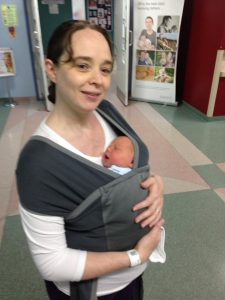
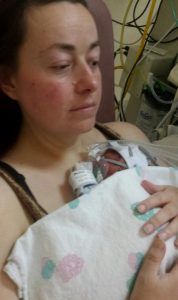
This is also very possible, and it could be argued, perhaps more important post section than after a normal non-instrumental vaginal delivery, depending on how the individual feels after the surgery. Achieving skin to skin as soon as possible is ideal, for promoting oxytocin release and bonding. This is vitally important after a section, especially if it was emergency and traumatic, thereby interrupting many of the biofeedback mechanisms around bonding. It is also important if the section was planned and baby was thus delivered before the biological hormone cascades of labour and birth were able to begin. There can be a strong tendency for women who did not have the birth experience they wished for to feel robbed and deprived of an important part of their baby’s arrival. The subsequent feelings of sadness and grief, or disappointment or that they have let themselves or their baby down somehow, however untrue, can significantly hamper the forming of attachment bonds and play a part in later postnatal depression or other mood disorders.
Mothers who experience this are very likely to find that skin to skin contact and frequent close touch and carrying extremely useful; the process of initiating and mantaining contact and loving touch often acts as a catalyst for the oxytocin release; this positive feedback mechanism will encourage loving feelings to develop despite the less than “perfect” start and get bonding well under way.
As soon as surgery is safely over and a well baby can be given to its mother, skin to skin can begin; resting on the mother’s chest under a blanket, inside a shirt or with kangaroo care clothing. Women are entitled to this skin to skin and should insist upon it; baby does not need to be washed or the cord to be cut before contact is achieved; the sooner the better.
Once mother is ready to move around and carry her child in her arms she can; she is advised to carry nothing heavier than her baby. Some women will choose to use slings immediately, if they feel ready (especially if they are already familiar with slings and feel confident with their use), others will wish to wait, especially if they feel unwell or are in pain. If the mother is confined to hospital and alone for parts of the day and wishes to move around, she may find the sling will help her to feel safer than carrying her baby loose in arms while she is still a little unsteady.
“Having a sling for carrying was very useful, as much easier and less painful than carrying in arms (less stress on abdominal muscles). It was great for bonding, especially since we were having trouble with breastfeeding.” Rebecca
The key factor is to avoid any carrier from irritating the wound or putting pressure on the abdomen. Double layer kangaroo-care shirts or other soft carriers such as stretchy or woven wraps, high-carrying waistband-less meh dais or buckle-tais and ring slings in frontal tummy to tummy carries, may be options to consider. Baby’s legs should ideally be tucked into the M shape, and this will also help to avoid feet kicking against a still tender wound. As the scar and any abdominal pain heals, carriers with more structured waistbands will become more accessible.
General tips about post-partum carrying (including fitness classes)

Participating in postnatal recovery programmes can be useful; however combining carrying and exercise/dance is usually best done with great caution as not every provider will have adequate knowledge about postnatal recovery (pelvic floor and diastasis recti issues) or about the rate and speed of each woman’s individual recovery from birth. Many may have no specialist knowledge about safe sling use or how to protect a baby from sudden shaking movements, as well as how to avoid overloading still-recovering tissues with certain stretching or weight-bearing activities with the extra load of a child in a sling. Walking with a baby in the sling, ensuring good alignment and posture, gradually increasing the speed and duration, is usually enough exercise for most women in the early months. Please do not rush; pelvic floor dysfunction is very very common (14 million women in the UK are known to have an issue, and many many more never seek help and remain undiagnosed). Leaking is NOT normal or to be expected. If you are unsure if your pelvic floor is recovering normally, please see your GP.
Read more about babywearing fitness classes here.
Using a sling allows families to settle back into the normal rhythms of daily life.
Often, older siblings are uncertain about the new addition to the family and uneasy about their place in it; they may need extra reassurance with the birth of a new baby. They may wish to return to their mother’s arms and be close to her body, for reassurance and reinforcing of the attachment bond.
Toddler carrying after birth
“During the intense post-birth bonding period with D I began to use a couple of wraps that had been favourites of R (the new big brother). It almost felt like a betrayal! But one afternoon, R asked if he could come up for a front carry in his favourite wrap, something he hadn’t done for ages, and we twirled round the lounge together laughing while my husband cuddled the new baby. I think that was a really healing moment for us and let my eldest know he still had an important place in my arms too.’ Emma
However, toddler carrying after birth is much more of a challenge, especially if the pelvic floor is weak and there is diastasis recti (separation of the abdominal muscles from the stretching during pregnancy). Please seek help if your floor or core are weak.

Involving the whole family!
The post-partum period may be a great opportunity for other caregivers in the family to share the carrying and begin the bonding process. Whole families thrive when children are kept close; it spreads the load of child care around. Partners can carry their newborns, or their older children to provide reassurance.
“Carrying our eldest son (3) enabled my wife to give her attention to our new baby. It gave us much needed daddy and son bonding, at a time when he was feeling insecure with the arrival of the new baby.” Mal
Remember, it is the closeness and contact that matters; in arms carrying is as valuable as using a sling, and the shifting of your growing baby around your body as your muscles tire will help to rebuild your strength and endurance. Sharing the carrying with other members of your family will help to strengthen relationships and reduce the strain on your own body too.

